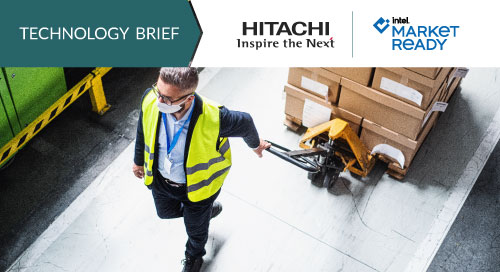Health and Safety: Priority #1 in the Smart Factory

No matter the industry, the most important objective for any business is to keep its employees and customers safe. But COVID-19 has added a degree of difficulty to this mission. To prevent the spread of this ongoing virus, organizations need to review and update their standard business procedures—offering transparency into how they’re achieving their goals.
Early on, many companies turned to quick fixes such as temperature guns for frontline detection. But such labor-intensive methods have proven to be invasive, difficult and expensive to scale, and put workers at risk by requiring them to be in close contact with others.
“Business leaders knew they needed to find a better system,” says Justin Bean, global director of marketing for Hitachi Vantara’s Smart Spaces and Lumada Video Insights. “They were saying, ‘How can we do our part, comply with the rules and regulations, and keep people safe?’ Not only is it the right thing to do; it also makes good business sense.”
To help its customers do just this, Hitachi Vantara, a leader in IoT and digital innovation, combines sensors with real-time video analytics and cloud-based data management. The company’s Digital Health and Safety Solution—an intuitive automated set of technologies—helps companies mitigate the risks of COVID-19. Combined with its broad digital technology solutions and strategy consulting, customers can achieve broader operational goals.
AI and Computer Vision Make the Smart Factory Safer
The first layer of defense is to flag people with elevated body temperature. Smart cameras equipped with thermal sensors put intelligence to work at the edge, monitoring the infrared spectrum of a person’s face as they walk into a facility. Scanning multiple facial points, AI can get a more accurate measurement of body temperature than simple infrared measurements. If it detects someone with an elevated reading, an alert is sent, allowing organizations to take appropriate action, such as administering a secondary test, or asking the person to quarantine.
In addition, the detection solution runs analytics to identify which shifts may be impacted so organizations can initiate action to prevent further spread. The data around the incidents, which includes video clips, images, PDFs, audio files or interviews, and test results, is stored in a digital archive where it can be organized by case and pulled up and shared with the appropriate people. And the same technology can be used to sense other criteria, such as if employees are wearing the right PPE or masks during COVID-19.
3D-Lidar generates an accurate 3D point cloud that creates a depiction of what’s happening in real time—without collecting personal information.
Preserve Procedures While Protecting Privacy
3D-Lidar is also a critical layer of protection. “3D-Lidar is like sonar, but it uses lasers,” explains Bean. “It measures the time of flight of those lasers and how long it takes them to bounce back. It also generates a very accurate 3D point cloud, creating a depiction of what’s happening in real time as people and objects move, without collecting personal information.”
For example, Lidar technology can be used to verify proper handwashing procedures for healthcare or food service workers. Since no personally identifiable information is collected, privacy is maintained and this opens up new use cases that would otherwise be too sensitive. It can also deliver information about proper social distancing by mapping a person’s journey throughout a facility. Lidar can even provide alerts for areas where social distancing is an issue. This enables organizations to target educational campaigns, and redesign or restrict capacity in that space to allow more distance.
While these tools are being used to address the risks of COVID-19, they also serve plenty of uses for general health, safety and environment (HS&E) monitoring. For example, the solution can detect whether employees are wearing helmets or gloves on the factory floor and monitor whether they’re following correct protocols and procedures.
Beyond the Technology
Sensors and edge gateways collect and process the data, but the greatest potential is in how this information can be used. “Data is displayed geospatially and graphically to ‘slice and dice it’ in whatever ways that customers need to enable smarter decisions and processes,” says Bean. For example, analytics can help managers understand where compliance is not being met and dig deeper into operational procedures to identify and correct areas of risk.
To make the most of the technology, companies need the right strategy to help them use move forward. Hitachi Vantara provides a combination of strategic consulting services and proven solutions to help companies improve processes, culture, and financial outcomes.
“A big part of this is setting the right strategy so that you can improve processes and systems,” says Bean. “This can help organizations improve change management to drive successful and sustainable results.”
The company’s partnership with Intel® helps maximize the solution value.
“Intel is at the core of how we’re able to perform the intelligence,” says Bean. “The raw data itself is not that useful. With tools like AI that analyze the video and 3D-Lidar data, we’re able to run more sophisticated analytics to give us new types of insights. Intel provides the platform to do that type of processing and to do it at the edge—improving speed, reducing costs, and further protecting privacy. Not only is it important to protect human health and safety and the livelihoods of our people, it also makes business sense.”